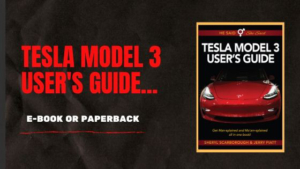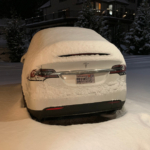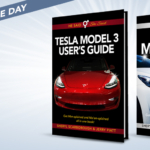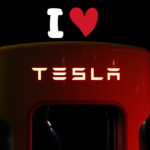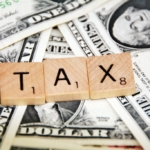5 States, 4 Nights, 3 Hotels & 2 Blizzards: How to finesse a Tesla Road trip.
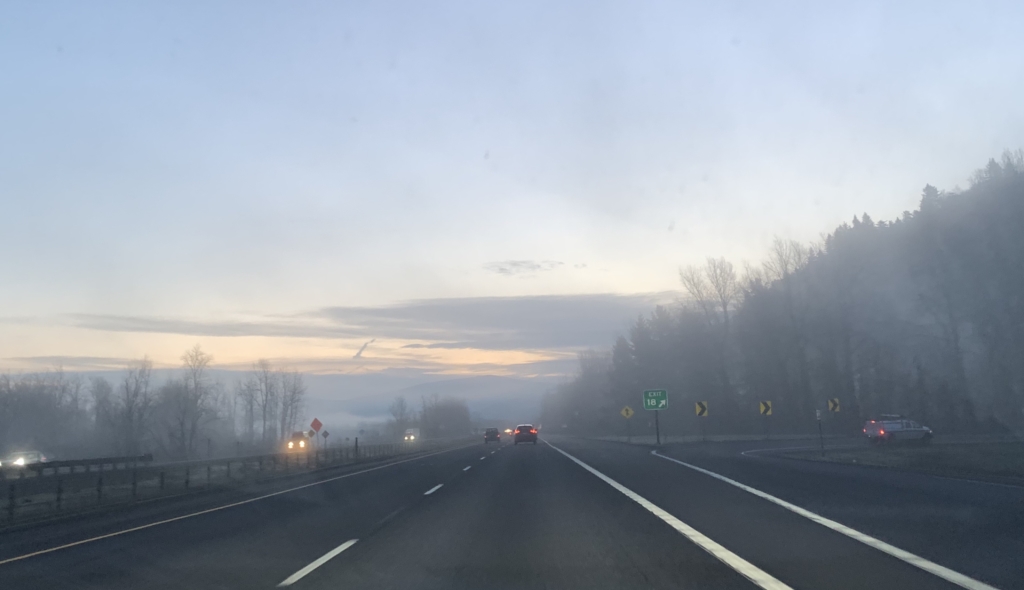
SHE SAID: We hadn’t planned on a spontaneous vacation in early February to Denver, Colorado. But then our youngest son hadn’t planned on slipping on a patch of black ice and breaking his leg (in two places), either! We had one day to contemplate the situation and the next day to pack and plan a quick road trip. When outsiders (meaning non-Tesla drivers) question the feasibility of a road trip in our “fancy car” we always quickly enthuse about how easy and mindless they are in our Tesla. And road trips are easy. But they’re not exactly mindless. EV road trips take careful planning, especially when traveling off the beaten track and in cold weather.
5 states: Washington, Oregon, Idaho, Utah and finally, Colorado. 1,400 miles of fairly straight highway, with some elevation. But in February we knew we would face weather and temps as low as 10 degrees. We know what cold and weather does to range. Since this was a rescue mission, we couldn’t afford any mishaps or time delays.
BEFORE WE LEFT
We plotted a course.
Checked the weather.
Re-plotted our course based on the weather. (i.e. We decided to skip Wyoming.)
Charged Pearl, our Model 3, to 100%.
Packed up her up and left only 15 min. behind schedule.
DAY ONE:
Drive from Vancouver, Washington to Twin Falls, ID—a 560 mile, 8 1/2 hour drive, without charging stops. I’m going to let my counterpoint jump in here and describe how he configured the A Better Route Planner route to our best options…
HE SAID:
The online Tesla trip planner is okay. The one at abetterrouteplanner.com is better. It allows you to be much more specific about the speed you want to drive, the minimum charge level you want to arrive with, the temperatures and road conditions you anticipate, etc. In taking all this into account, it gives a more accurate projection of where you can and should stop for charging and where you may need to reduce your speed in order to make the next charger.
I configured (rather optimistically) for a maximum speed of 80 MPH in temperatures of 20º F on rainy/snowy roads and specified a preferred arrival charge level of at least 20% at each supercharger but a minimum of 15%.
Our plan for day one looked like this:

That last leg is red because ABRP is telling me we’ll have to drive below the speed limit to reach the charger in Twin Falls with my specified minimum charge of 15%. The drop-down plan/schedule is more specific, stating we must drive at 74 MPH or less during that leg. (Note all the other good info you get in this view)

You can also bring up ABRP on your web browser in the car and, if you have configured it with your Tesla login credentials, it will use “live data” from the car to monitor your progress against the planned drive (plan your drive and drive your plan). In this way, you can adjust your speed, if necessary when you see your projected arrival charge level is falling lower than you intended.
A word about reduced speed driving. Although the speed limit is 80 MPH on some of these interstate legs, it is surprising how many people do not drive that speed. I had plenty of company driving at 70 MPH and even at 65 on some stretches. Don’t be afraid to adjust your speed to reduce your range anxiety.
SHE SAID: He figures things out . . . like that reducing our speed is the way to go. Then I try to analyze (also known as backseat driving) to determine if he’s right. Don’t question it, we’ve made it work for 20 years so far. In this case I wanted to know which method would save the most time: driving slower and arriving with more charge OR driving at or above the speed limit, risking our desired arrival range and then being required to spend more time SuperCharging.
Tesla Road Trip Theory suggests that you don’t fill up each time, you only charge enough to get you to the next SuperCharger. But on a critical road trip outside of California (where there are multiple charging options) you may need to be a bit more circumspect.
That last 10% or 20% of charge can be agonizingly slow. And, if you happen to stop at a SuperCharger which experiences heavy traffic, the amount you are allowed to charge might be capped at 80%. The system has no way of knowing that you are about to venture into the wilds where there are no other charging options and maybe you wanted some cushion.
I can’t say that we managed to gather definitive proof of which way was actually faster. But we did agree that the speed reduction didn’t cost us as much time as you might think. AND, in the end we concluded driving slower is the better option if you’re trying to maintain range and don’t have a number of SC options you can rely on.
DAY TWO:
Twin Falls, ID to Denver, CO: almost 700 miles and a 10 1/2 hour drive without SC stops. We left Twin Falls as early as possible as we were trying to get to the hospital in time for them to discharge our son. On this drive we faced the lowest temps and the longest stretch between SuperChargers. We also were racing against incoming snow. As you can see below, the snow won! Our drive got longer due to reduced speeds, which helped with range, especially as the temps dropped to 10 degrees. We didn’t have range anxiety exactly but we did keep a careful eye on it. We arrived, wrung out and exhausted, with less than our recommended 15% charge. We would need to plug in overnight or risk an even lower battery condition in the morning. Fortunately, the hotel we booked had an EV charger. And it really paid off as the nearest SC was 15 miles away and it was still snowing!
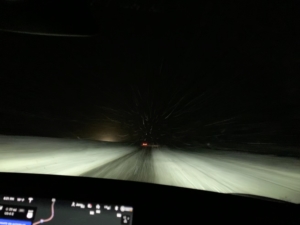
HE SAID:
The suggested ABRP plan for day two looked like this:
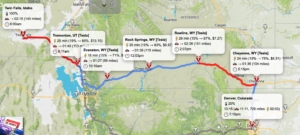
But this is winter in the Rockies and my main concern was snow and extreme low temps as both would affect range so I checked another website (morecast.com) to find about about weather on the route. I didn’t save that screen shot but here’s one I took today that’s similar:
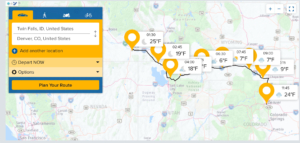
On the day in question, temps on this route through Wyoming were closer to 0º F on many stretches. When I checked the southern route (through Grand Junction, CO) they were about 15º – 20º warmer so we adjusted the plan to go south. Note, also that we eliminated one of the “red” legs from our route.
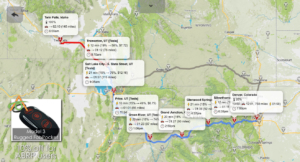
DURING THE DRIVE (recap):
Pre-conditioned before leaving each morning.
Made a SuperCharger stop on way out to top off the tank and prep the battery for the road.
Planned (or rather skipped) eating stops in order to maximize charging past 80% whenever possible.
Reduced speed to 65 in 80 MPH zones. It was harsh, but necessary
Booked hotel with EV charger (This saved our bacon in the Westminster suburb of Denver as we arrived late at night with less than 15% charge and no nearby SC.)
WE MADE IT! Arrived at the hospital in Denver at 11:00 at night . . . 17 hours after we left Twin Falls. The last two hours of the drive was through a full-on blizzard. Indentations from our white knuckled grip still remain on the steering wheel and passenger door handle grip.
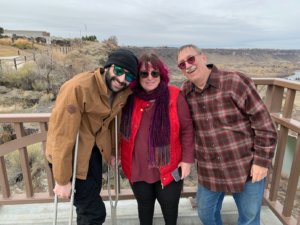
Snake River Canyon. The Twin Falls Tesla SC faces this location and it’s spectacular to see in person. There’s an Outback nearby and outlet shopping. Great location.
HERE’S WHAT WE LEARNED:
Our Tesla Travel Kit is an expanding and evolving work-in-progress. Here’s what we recommend you don’t leave home without.
TESLA TRAVEL KIT:
Tire Repair Kit
Combination snow brush / windshield scraper
Snow chains
Windex Wipes (great for cleaning dead bugs and road dirt off the cameras. It’s good for the windows, too. But the cameras FTW!)
Plastic Poker-Jabber (To remove ice from a SuperCharger connector that had apparently fallen into the snowbank.) We used the scissors from a manicure set we had in the car, but this experience has lead us to search for the perfect multi-tool. Plastic because high voltage. But it has to be sturdy so it doesn’t break off in the connector and cause even more problems than it could solve. SHE SAID: We’re still searching but it seems like a prison shiv made from a toothbrush would be perfect. Not that I actually know anything about prison shivs…but I’ve seen them used on TV. We’ll keep you posted on our progress on this.
Tesla road trips are awesome as long as you make a plan and then drive it. Don’t be afraid to take your Tesla and get out and go. If you have any other Model 3 questions, check out our User’s Guide by clicking on the image below.

